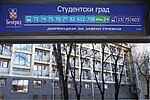Fontana, Belgrade
Neighborhoods of BelgradeNew Belgrade

Fontana (Serbian: Фонтана) is an urban neighborhood of Belgrade, the capital of Serbia. It is located in the municipality of New Belgrade.
Excerpt from the Wikipedia article Fontana, Belgrade (License: CC BY-SA 3.0, Authors, Images).Fontana, Belgrade
Pariske Komune, Belgrade New Belgrade (New Belgrade Urban Municipality)
Geographical coordinates (GPS) Address Nearby Places Show on map
Geographical coordinates (GPS)
| Latitude | Longitude |
|---|---|
| N 44.825438 ° | E 20.409033 ° |
Address
Pariske Komune 13
11000 Belgrade, New Belgrade (New Belgrade Urban Municipality)
Central Serbia, Serbia
Open on Google Maps









